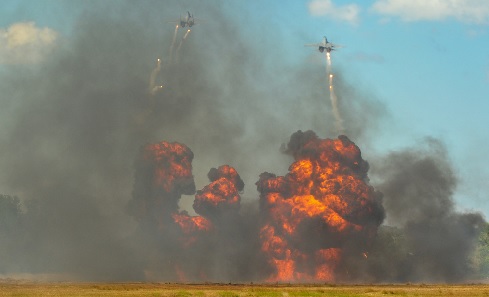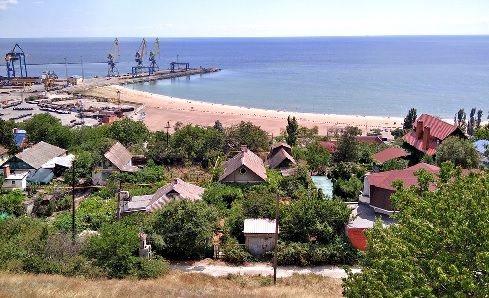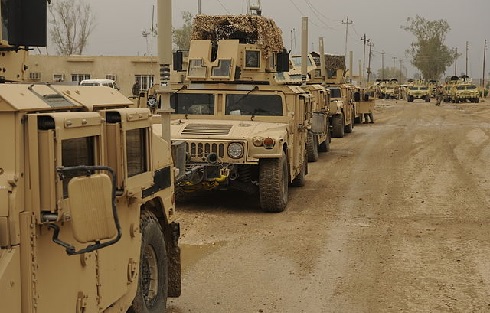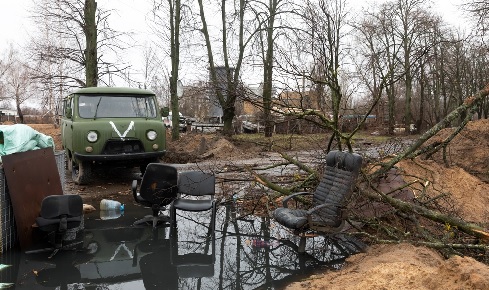War on the world

Tom Ireland explores the potential for environmental disaster in eastern Ukraine – and how the pollution and degraded landscapes of war drive further conflict
May 23rd 2022
The Novhorodske phenol factory lies roughly 35km north of the city of Donetsk in eastern Ukraine. Inside this mass of concrete towers and rusting metal pipes, toxic chemicals were once used to extract valuable chemicals from coal. Vats of corrosive chemicals lie in dilapidated tanks and toxic waste from the plant is stored in a reservoir nearby. The reservoir has been in desperate need of critical repairs for many years and lies worryingly close to water supplies for the nearby town.
In 2017 the situation here became even more precarious than it was already, as the front line of the conflict in eastern Ukraine came to the town of Novhorodske. Ukrainian forces and separatists were separated by just 400 metres[1] and between them was the phenol factory’s chemical waste pool. The threat of a vast environmental and public health disaster – one that would surely affect both sides – didn’t stop them shelling each other’s positions.
Early in this year’s large-scale invasion of Ukraine attention understandably focused on the site of the Chernobyl nuclear disaster and the threat of damage to its delicate protective infrastructure. In truth, however, the whole of Ukraine – and particularly its embattled east – is a highly industrial landscape dotted with thousands of industrial facilities, abandoned mines, and toxic and radioactive waste stores.
Threats to the environment in conflict zones may seem like a low priority at a time when many people are fleeing violence, fighting, grieving and in desperate need of medicine, food, water and shelter. But wars like the one in Ukraine threaten the very air, water and soil that millions of people depend on, with consequences that can last for decades or spread far beyond the region of conflict.
An hour’s drive south from Novhorodske towards Donetsk is the Verkhnikalmiuska Filter Station, where more than 300 tons of liquefied chlorine are stored in pressurised tanks for water disinfection. Estimates of a worst-case scenario here predict that an explosion could affect the air and water quality of up to 400,000 people. Yet satellite images in 2017 showed separatist forces stationing artillery next to the station, turning the dangerous site into a target for missile strikes[1]. Shelling at similar water-filtering stations in Donetsk itself and nearby Gorlovka threatens the water supplies for over two million people in the region.
 Morning fog over the eastern Carpathians in the Ukrainian countryside.
Morning fog over the eastern Carpathians in the Ukrainian countryside.  The Ukrainian port city of Mariupol, before the Russian invasion of 2022.
The Ukrainian port city of Mariupol, before the Russian invasion of 2022. A global problem
Environmental damage caused by war can take many shapes and forms, from attacks on industrial facilities and water supplies to the deliberate burning of land, or habitats polluted with destroyed equipment, toxic explosives and fuel. Conflict also dramatically reduces a country’s ability to monitor, manage and repair dangerous or environmentally sensitive sites. (Just a few days into the conflict, fewer than half of Ukraine’s 1,300 air-monitoring stations were submitting data and only 149 of its 331 radiation-monitoring stations were online.)
On occasion, war drives humans from an area for an extended period, allowing the regeneration of biodiverse habitats free from human activity. But generally, war is a disaster for the environment. Conflict in different places, fought in different ways, causes different types of environmental destruction; in Iraq in 2018 hundreds of thousands of hectares of forest and scrubland were destroyed by wildfires sparked by artillery fire between insurgent groups and Turkish and Iranian forces[3]. The following year vast agricultural areas were set ablaze by ISIS as the last pockets of the organisation’s fighters tried to extort money from local farmers[4].
 Heavily armoured military vehicles, especially older ones, are among some of the least fuel-efficient and most polluting vehicles in the world, and military planes and boats use particularly climate-harmful fuels. If the US military were a nation state, it would be the 47th largest emitter of greenhouse gases in the world just from its fuel use alone.
Heavily armoured military vehicles, especially older ones, are among some of the least fuel-efficient and most polluting vehicles in the world, and military planes and boats use particularly climate-harmful fuels. If the US military were a nation state, it would be the 47th largest emitter of greenhouse gases in the world just from its fuel use alone.In Yemen, the war has exacerbated a long-standing water shortage across the interior of the country. The UN is also desperately trying to organise action to rescue a decaying tanker containing over a million barrels of oil, four times the amount carried by the Exxon Valdez, the tanker that caused one of the largest environmental disasters in US history. The tanker has lain stricken off Yemen’s west coast for almost 30 years, but war in the country caused maintenance and offloading operations to cease in 2015, and it is now “beyond repair”[5].
Between 1977 and 1992 the Gorongosa National Park in Mozambique lost more than 90% of its animals during the country’s 15-year civil war[6], and in Columbia studies have shown that paramilitary groups reduced forest cover in areas where they operated[7]. Going back even further, historians have noted how the desolate battles of the American civil war caused an “ecological disaster” that led to “increased incidence of disease … deleterious effects on farms and forests, and the devastation of animal populations, wild and domesticated”.[8]
Environmental impacts can be far-reaching and not necessarily a direct result of guns and bombs. For example, as the European Union bans timber imports from Russia and tries to reduce fuel use, the Conflict and Environment Observatory has warned this is likely to lead to more European forest being cut down and replaced with biofuel monocultures. And the ultimate far-reaching effect of war is its impact on our climate.
In March the world saw ominous satellite images of a convoy of Russian military vehicles to the north of Kyiv stretching for a reported 40km. As well as being a disturbing sight for the residents waiting in their path, the images showed the mind-bogglingly vast logistical operation that supports war. Heavily armoured military vehicles, especially older ones, are among some of the least fuel-efficient and most polluting vehicles in the world, and military planes and boats use particularly climate-harmful fuels. A 2019 report by Durham and Lancaster University found the US military “consumed more liquid fuels and emitted more CO₂e (carbon-dioxide equivalent) than most countries”. In fact, if the US military were a nation state, it would be the 47th largest emitter of greenhouse gases in the world just from its fuel use alone[9].
 A better understanding of the environmental impact of war could help communities rebuild and restore landscapes more effectively and safely.
A better understanding of the environmental impact of war could help communities rebuild and restore landscapes more effectively and safely. Last year world leaders convened in Glasgow and Kunming, China, for precarious talks on how nations can achieve crucial reductions in carbon emissions and prevent further degradation of nature. Almost all nations agree these changes are urgent and vital to safeguard the future of humanity, and while the talks did not achieve the outcome many wanted, important agreements were made relating to carbon emissions, deforestation and land degradation. To support these objectives more and more people around the world have been making whatever small sacrifices they can to help reduce their impact on the environment.
How heartbreaking, then, to see just a few months later a new conflict, and vast oil depots set ablaze, entire cities pulverised into rubble, convoys of fuel-laden armoured vehicles blasted to bits, toxic waste sites used as battlefields, and literal scorched Earth from missile strikes – all at the whim of one man and his imperial ambitions.
Crimes against nature
So what can be done? In 2021 a panel of 12 lawyers from around the world submitted official proposals to make the destruction of nature – or ‘ecocide’ – an international crime similar to genocide. The idea of ecocide as an international crime is not new – it was first suggested at a UN conference in 1972, and was considered and dropped when the International Criminal Court (ICC) was established in 1998. However, several member nations of the ICC are expected to propose a new ecocide crime to the court in December this year – the most likely candidates being island nations threatened by rising sea levels and climate change[11]. It will require a simple majority of the ICC’s 123 member countries for the proposal to be considered, but two-thirds must vote in favour to approve and ratify the final text into law.
International humanitarian laws already state that the unnecessary destruction of nature must be avoided in conflict. The UN International Law Commission has been attempting to strengthen this framework and the development of a new set of 28 draft principles (known as Protection of the environment in relation to armed conflicts, or PERAC) is set to conclude in autumn 2022. Early analysis has found many states oppose the project[12], and even if humanitarian law in this area is strengthened, it is unlikely to be at the forefront of the minds of the despots and generals who have such little regard for the law and for life.
Surprisingly, there is some evidence that arms makers are making an effort to make their tools of death and destruction more eco-friendly, with Greenpeace reporting plans for “energy-efficient lasers, solar submarines and gas-powered assault ships as their contribution to tackling the climate crisis”[13]. However, the ludicrous oxymoron of ‘sustainable weapons’ is likely to have more to do with the world’s dwindling oil supplies than a respect and love for nature and humanity, and energy-efficient weapons do nothing to change the destructive and polluting nature of war.
Some will argue that perhaps the environment can never be rigorously protected in times of war. Short- and long-term environmental crises loom across the world, resources to tackle these problems are limited and even at the best of times it is difficult to enact meaningful social change to redress anthropological causes. War is a distinct and chaotic state that few ever choose to inflict upon their communities, and when people are fleeing violence or defending their homeland it is understandable that the health of their environment falls further down their list of priorities.
Nonetheless, we should try to better understand the scale of war’s impact on the environment. More information about it could help those affected avoid hazards and safely restore the landscape they find themselves in following conflict. Open-source intelligence has made it easier than ever to monitor threats to environmentally sensitive sites remotely and in real time, and collectives of citizens can and are helping drive these investigations.
Most major academic studies exploring the relationship between natural resources and conflict have looked at how environmental factors lead to conflict, not the other way round. As we tip ever closer to ecosystem collapse in many parts of the world it is time to look seriously at how war contributes to destruction of natural resources and ecosystem services, and how this in turn fuels future conflicts. And, of course, how to hold the biggest perpetrators of crimes against our world accountable.
Tom Ireland MRSB is editor of The Biologist.
1) Zwijnenburg, W. Donbas: A ticking toxic time bomb. www.bellingcat.com 30 March 2017.
2) Environment and conflict alert Ukraine: A first glimpse of the toxic toll of Russia’s invasion of Ukraine. www.paxforpeace.nl 9 March 2022.
3) Burning borderlands: open-source monitoring of conflict-caused wildfires in Iraq. www.bellingcat.com 11 September 2018.
4) Torching and extortion: OSINT analysis of burning agriculture in Iraq. www.bellingcat.com 3 June 2019.
5) UN unveils plan to prevent stricken oil tanker disaster off Yemen coast. news.un.org 8 April 2022.
6) Natural environment: neglected victim of armed conflict. The International Committee of the Red Cross. 5 June 2019.
7) Fergusson, L. et al. The environmental impact of civil conflict: the deforestation effect of paramilitary expansion in Colombia. Documento CEDE No. 2014–2036 (2014).
8) Brady, L.M. Environmental war. The Cambridge History of the American Civil War: Volume 2 (ed Sheehan-Dean, A.) 249–267 (Cambridge University Press, Cambridge, 2019).
9) Belcher, O. et al. Hidden carbon costs of the ‘everywhere war’: logistics, geopolitical ecology, and the carbon boot-print of the US military. Trans. Inst. Br. Geogr. (2019).
10) Seven things you need to know about climate change and conflict. The International Committee of the Red Cross. 9 July 2020.
11) It is time to make ecocide an international crime. www.openglobalrights.org 12 January 2022.
12) States reluctant to strengthen laws protecting the environment from war. Conflict and Environment Observatory. 8 March 2022.
13) How weapons manufacturers are preparing for climate change. www.unearthed.greenpeace.org 26 May 2020.


